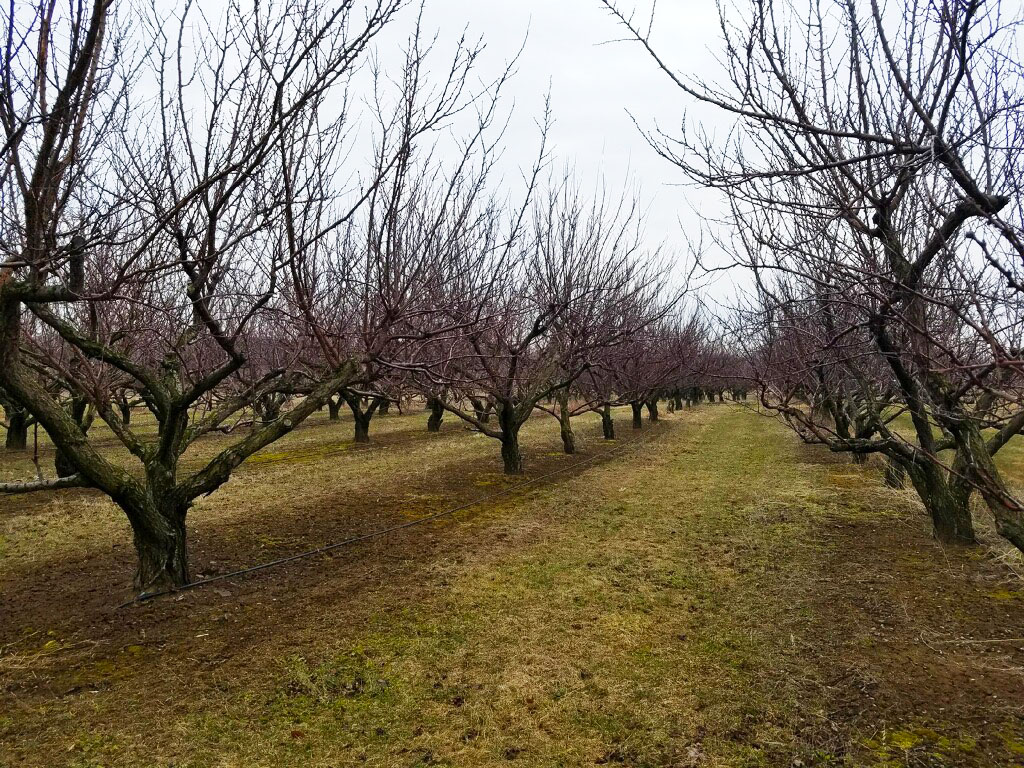Will Apples be Victims of a Changing Climate?
By Nicholas Zaremba
“This is where I grew up,” said Joe, as we drove up to his family farm, a modest three-story white house with rows of fruit trees behind it. The farm produces apples, peaches and blueberries. “We grow twenty-six varieties of dessert apples and more than 60 varieties of cider apples,” Joe said. “We’ve been farming in the area since 1811.”

Like other small farmers in Central and Western New York, Joe and his family must carry out a host of daily tasks – trimming trees, mowing, tilling the soil, maintaining equipment – to maintain their apple orchards from season to season. But like other farmers, they are also seeing disturbing changes in the length and duration of the trees’ growing seasons.
“The timing of trees coming into bloom has been more irregular than in the past,” Joe said. “Where there used to be a small yet regular window for the trees to start blooming, the window has gotten larger and more irregular. There can be a several week difference from year to year instead of a couple days of difference.”
America’s small family farms are rapidly disappearing, beset by economic, political and technological pressures. But a new threat is now on many farmers’ radars: climate change.
How apple production in the state will change as a result of climate change is important, considering that an estimated 17,500 New Yorkers are employed either directly or indirectly by the apple industry. In addition to the revenue that apple production provides, the industry has a long history in Central New York and is a big part of this region’s identity. Apples, as well as other industries in the area, such as dairy farms, are successful because of the region’s cool climate.
Recognizing the potential impact a warming climate could have on the area, New York State published a report on how the state’s high value agriculture industries might be affected as a result of climate change, with projections made to the year 2080. According to this report, the possibility of hotter summers with more frequent heat waves will probably decrease milk production if the industry does not adapt. Dairy farms in Central New York are already operating at close to the maximum heat index for profitability. Grapes used for red wine production in the state, Vitis vinefera, on the other hand, could benefit from warmer summers and a longer growing season. New York’s climate is already at the colder limits for this variety of grape.
The future of apples in the state is more uncertain. The report by New York State’s Energy Research and Development Authority stated that the production of Granny Smith and Fuji apples could benefit from warming temperatures. However, other apple varieties that are currently important to the local industry, such as McIntosh or Empire, could be negatively impacted. A reduction in the amount of winter chill hours (hours when temperatures are below 45 Fahrenheit) could decrease apple quality and production, according to the report. Information such as this might be helpful to a farmer who is currently planning on expanding their farm in the near future or replanting.
The predictions made by the report, though sobering, are very broad and might not be entirely accurate. There are many variables that affect apple production. Proactive measures such as planting a climate change-resistant apple variety are currently not feasible. But Susan K. Brown, a professor of Agriculture at Cornell University who breeds new varieties of apples, said her research group and others are looking at breeding a climate change-resistant apple for New York State.
“The problem is when it is non-predictable,” she said. “You can breed for drought, but then you can have flooding. If you breed for late flowering you can enhance susceptibility to certain bacterial diseases. However, we will continue to try to balance this.”
The report makes it clear that long-term proactive planning for the industry is important but difficult, because of the unpredictable nature of climate change. The report stresses that for agriculture to remain successful in Central New York over the coming decades, farmers need to adapt to a changing climate. To help farmers adapt, the report outlined “knowledge gaps,” which are areas of research that could provide valuable information that would aid farmers in proactively managing their farms.
Cornell University’s school of agriculture has already begun to address some of the knowledge gaps outlined by the report. The school has created interactive websites that provide farmers with important information that can aid in managing a farm during periods of unusual weather. Over the past 30 years, apples have been blooming earlier in the season, suggesting that climate change has already been having an impact on the industry.

When a tree blooms is important for the overall production and quality of the crop. Unseasonably warm winter temperatures could cause a plant to bloom earlier in the season. If this is followed by freezing nights in late spring, the crop could be severely damaged. The National Oceanographic and Atmospheric Administration (NOAA) reported similar weather patterns for February and March of 2016 and 2017, with abnormally high frost damage to crops in 2016. Low apple production in New York State in 2012 was a direct result of this type of weather pattern.
This year has seen a similar weather pattern: a relatively balmy February with highs in the mid 60’s for much of the region, and a frigid March and April. In order to combat these obstacles, Cornell’s school of agriculture has created a website containing the Apple Freeze Risk decision tool to help farmers better predict the possibility of losing a crop as a result of a late season freeze. The website was created based on input from farmers, and takes into account the variety of apples grown, the location of the farm, and various other factors. The information provided by the website is intended to help farmers make well-informed decisions on when to protect their orchards from frigid nights.
When it comes to protecting their livelihood, farmers are very proactive. With a great deal of uncertainty about what the future will bring, one strategy that an apple orchard can employ is to diversify its income sources. Joe’s family farm has been doing exactly that. Recently, his family has completed construction of a cidery and bar. They are beginning to brew and serve their own cider, as well as ciders from other parts of Central New York.
At the cidery, large glass windows provide a view of the orchard. While it is pretty in early spring, it is probably even more spectacular in late spring and summer when everything is in full bloom. Many of the customers are friends of Joe’s family, people who have lived in the area and have known each other for some time. The cidery provides another source of income for Joe and his family, as well as service jobs for other local residents.
While Joe helps out at the cidery when the farm work is less demanding, he has other ideas for making the farm more resistant to climate change, for example, by diversifying the crops they grow. This summer he plans on planting a variety of vegetables.
“The garden will contain heirloom varieties of: tomatoes, hot peppers, sweet peppers, radish, peas, beans, lettuce, cantaloupe, watermelon, squash, cucumbers, cabbage, eggplant, borage, sage, Russian comfrey, chives, and potentially more herbs and flowers,” Joe says.
He said he plans on starting small for now and selling the crops on site in the summer when the orchard is busy with visitors (the farm operates as a “u-pick” orchard in the summer). There are still obstacles to overcome before the new crops are planted, like providing a convenient and affordable source of water, and acquiring enough compost to support the crops. But starting a vegetable garden is another way farms can adapt to climate change. The initial time and financial investment in planting a vegetable garden is substantially smaller then compared to planting fruit trees. Unlike apple trees, vegetable crops can be altered from year to year. If a certain variety is not doing well because of changes in the local climate, planting a more suitable variety is substantially easier. And it’s not just Joe who has identified diversification as a key component for farms to remain profitable in the next decades. The New York Climate Change Science Clearinghouse has outlined diversification of crop varieties as one of the many suggested adaptations farmers should make.
By taking these steps now, when the effects of climate change are noticeable, but not as intense as they will likely become, Joe’s farm has a better chance of surviving variable and unpredictable weather patterns in the future. With the collective efforts of climate scientists, biologists, economists and politicians, motivated farmers like Joe’s family may be able to stay profitable for generations to come, preserving a classic American lifestyle, family heritage, and an important source of income for Central New York.
Photos by Nicholas Zaremba
